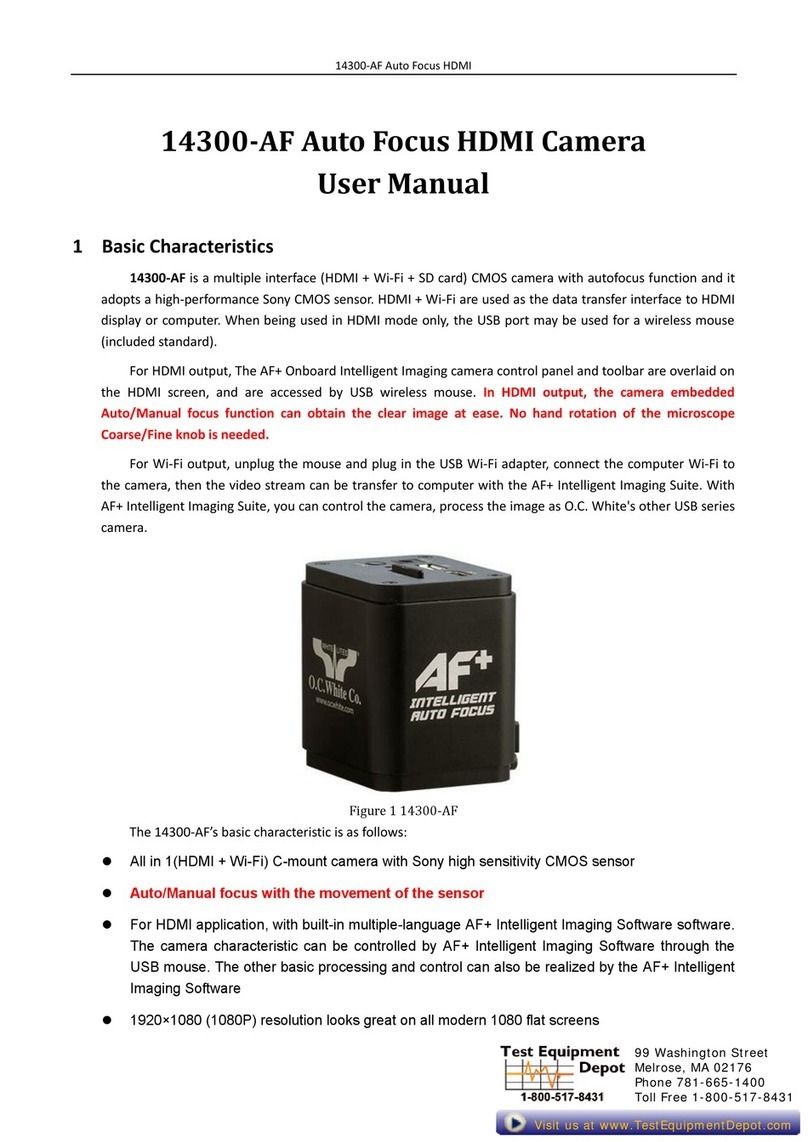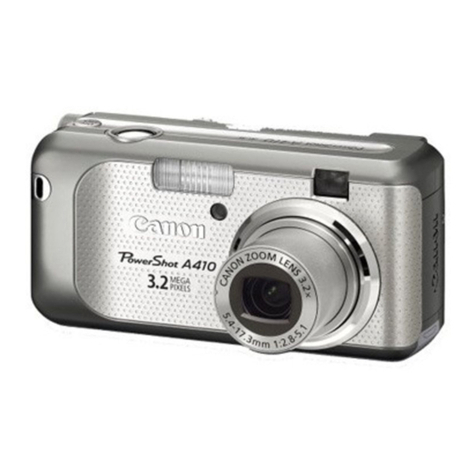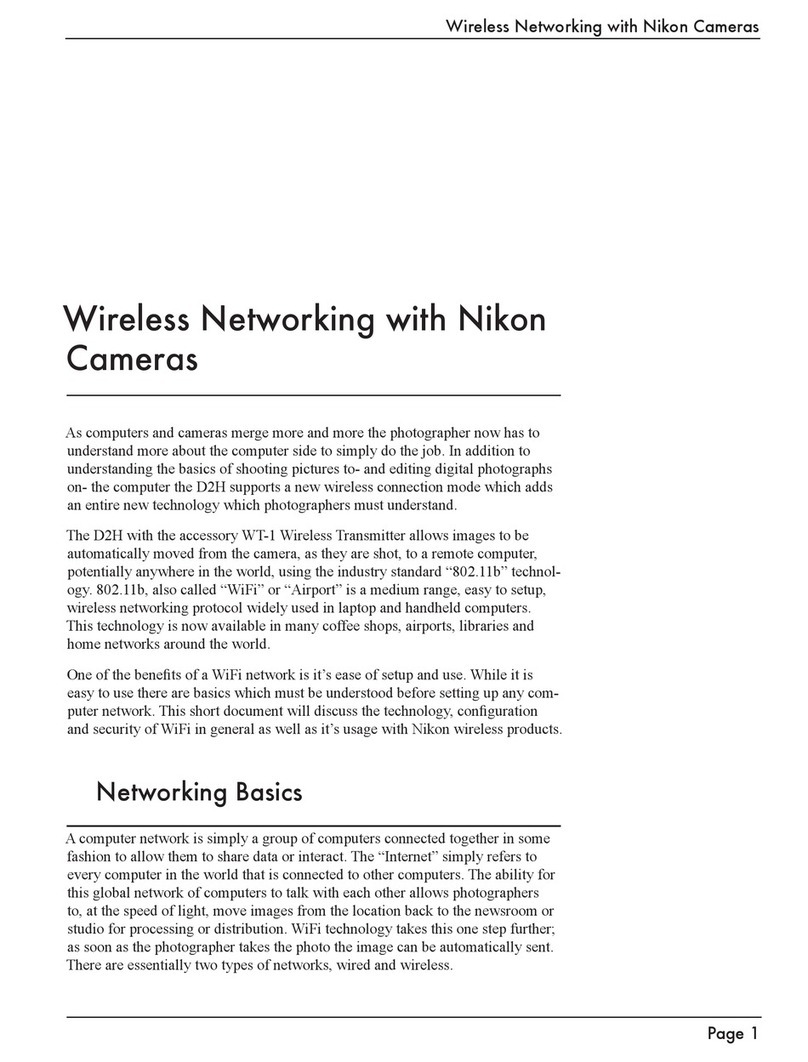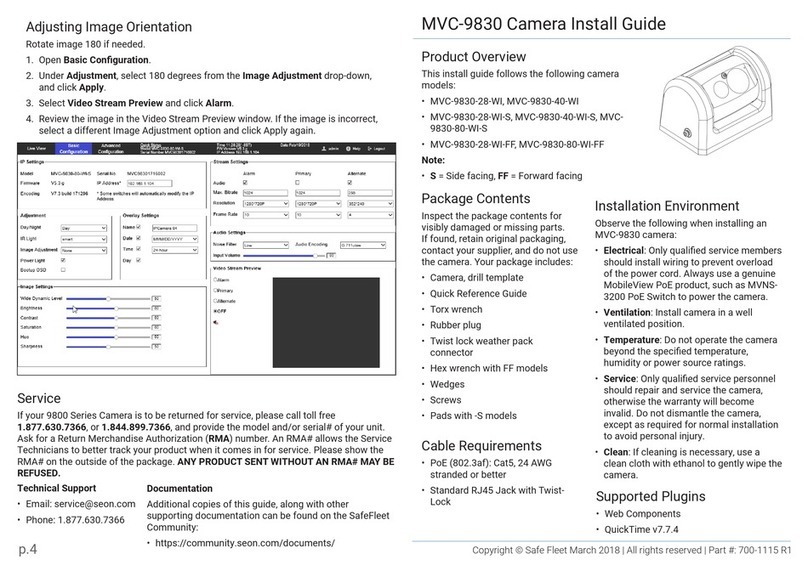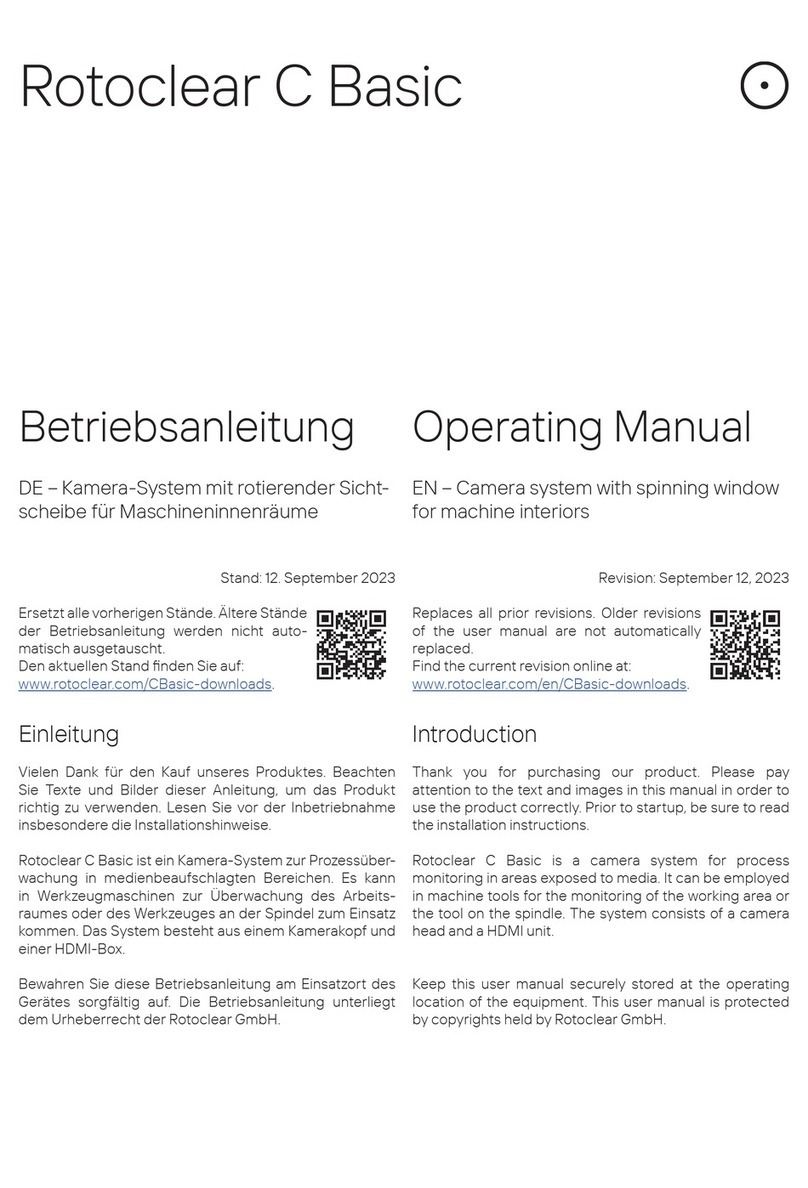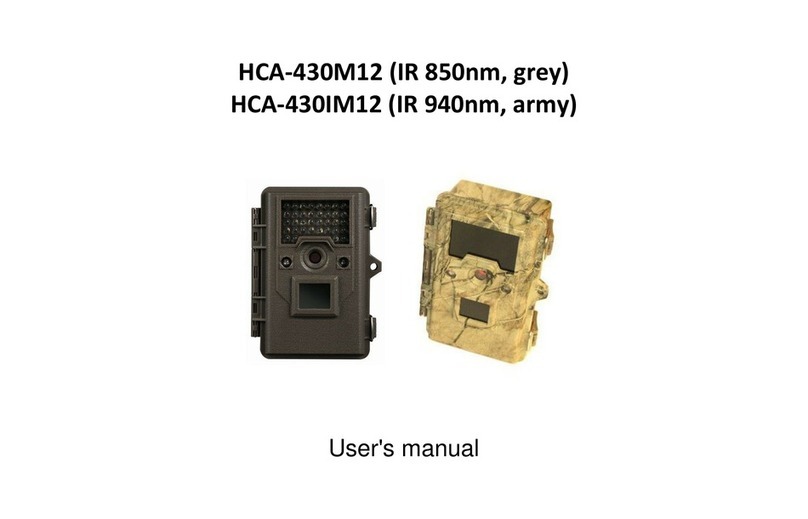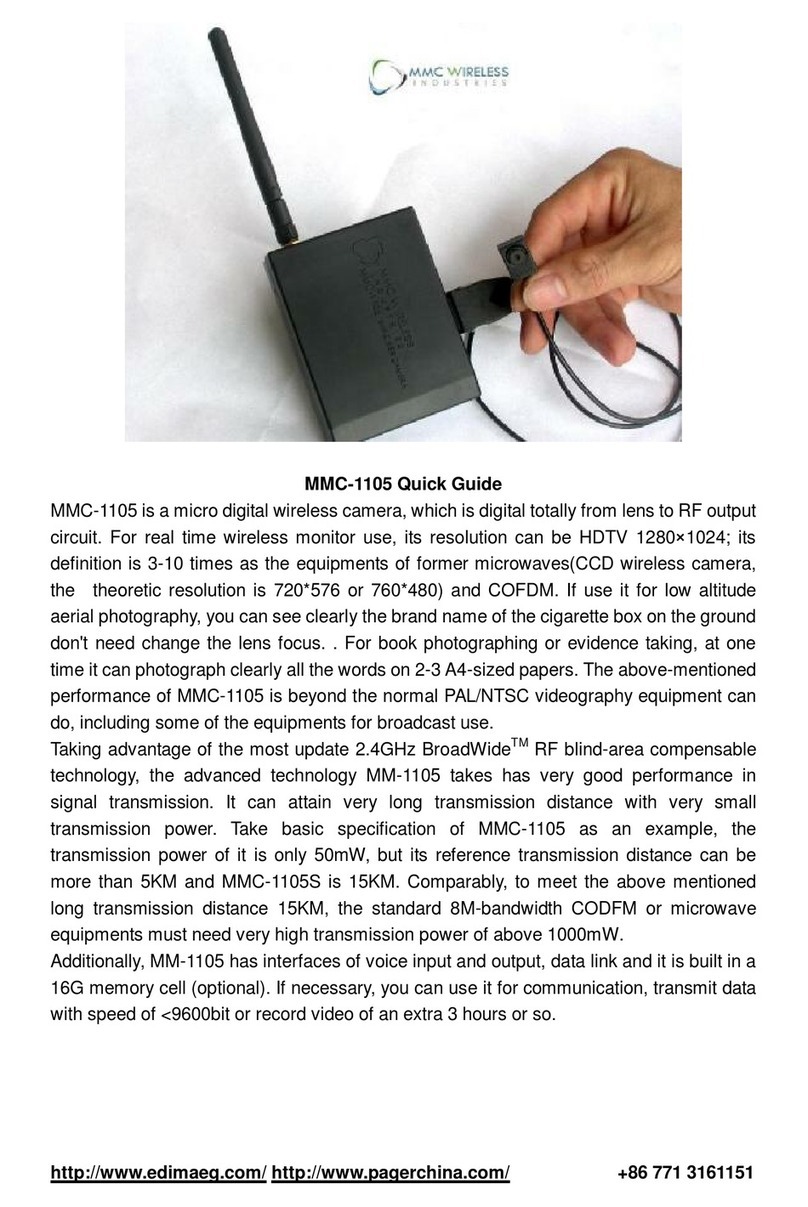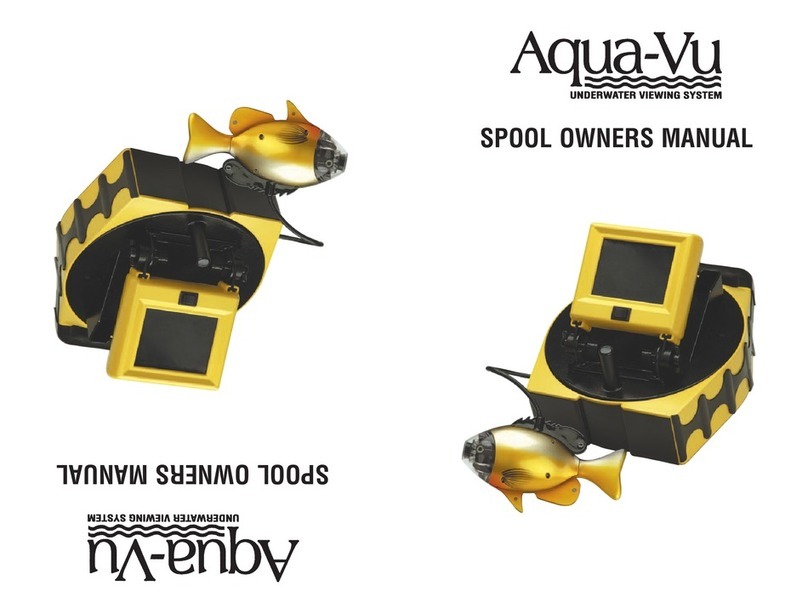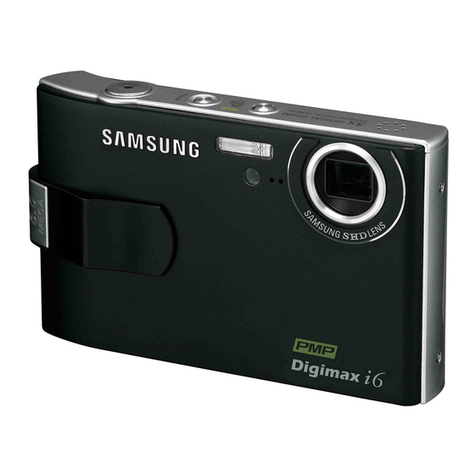Idis DC-T6223HRL-A User manual

Powered by
DC-T
Series
Installation Manual
DC-T6223HRL
DC-T6224HRXL
DC-T6223HRL-A
DC-T6224HRXL-A

2
This is a basic installation manual for use of an IDIS network camera. Users who are using this product for the rst time,
as well as users with experience using comparable products, must read this manual carefully before use and heed to
the warnings and precautions contained herein while using the product. Safety warnings and precautions contained
in this manual are intended to promote proper use of the product and thereby prevent accidents and property
damage and must be followed at all times. Once you have read this manual, keep it at an easily accessible location for
future reference.
• The manufacturer will not be held responsible for any product damage resulting from the use of unauthorized parts and
accessories or from the user's failure to comply with the instructions contained in this manual.
• The information in this document is believed to be accurate as of the date of publication. The manufacturer is not
responsible for any problems resulting from the use thereof. The information contained herein is subject to change
without notice. Revisions or new editions to this publication may be issued to incorporate such changes.
• It is recommended that rst-time users of this network camera and individuals who are not familiar with its use seek
technical assistance from their retailer regarding product installation and use.
• If you need to disassemble the product for functionality expansion or repair purposes, you must contact your retailer and
seek professional assistance.
• Both retailers and users should be aware that this product has been certied as being electromagnetically compatible for
commercial use. If you have sold or purchased this product unintentionally, please replace with a consumer version.
Safety Symbols
Symbol Type Description
IEC60417, No.5031 Direct current
IEC60417, No.5032 Alternating current
In-Text
Symbol Type Description
Caution Important information concerning a specic function.
Note Useful information concerning a specic function.
Before reading this manual

Before reading this manual
3
Safety Precautions
WARNING
RISK OF ELECTRIC SHOCK
DO NOT OPEN
WARNING: TO REDUCE THE RISK OF ELECTRIC SHOCK,
DO NOT REMOVE COVER (OR BACK).
NO USER-SERVICEABLE PARTS INSIDE.
REFER SERVICING TO QUALIFIED SERVICE PERSONNEL.
Important Safeguards
1. Read Instructions
All the safety and operating instructions should be read before the
appliance is operated.
2. Retain Instructions
The safety and operating instructions should be retained for future
reference.
3. Cleaning
Unplug this equipment from the wall outlet before cleaning it. Do not
use liquid aerosol cleaners. Use a damp soft cloth for cleaning.
4. Attachments
Never add any attachments and/or equipment without the approval
of the manufacturer as such additions may result in the risk of re,
electric shock or other personal injury.
5. Water and/or Moisture
Do not use this equipment near water or in contact with water.
6. Placing and Accessories
Do not place this equipment on an wall or ceiling that is not strong
enough to sustain the camera. The equipment may fall, causing
serious injury to a child or adult, and serious damage to the
equipment. Wall or shelf mounting should follow the manufacturer's
instructions, and should use a mounting kit approved by the
manufacturer.
This equipment and cart combination should be moved with care.
Quick stops, excessive force, and uneven surfaces may cause the
equipment and cart combination to overturn.
Do not place this equipment in an enclosed space. Sucient
ventilation is required to prevent an increase in ambient temperature
which can cause malfunction or the risk of re.
7. Power Sources
This equipment should be operated only from the type of power
source indicated on the marking label. If you are not sure of the
type of power, please consult your equipment dealer or local power
company.
You may want to install a UPS (Uninterruptible Power Supply)
system for safe operation in order to prevent damage caused by an
unexpected power stoppage. Any questions concerning UPS, consult
your UPS retailer.
This equipment should be remain readily operable.
8. Power Cord
Operator or installer must remove power and TNT connections before
handling the equipment.
9. Lightning
For added protection for this equipment during a lightning storm,
or when it is left unattended and unused for long periods of time,
unplug it from the wall outlet and disconnect the antenna or cable
system. This will prevent damage to the equipment due to lightning
and power-line surges. If thunder or lightning is common where the
equipment is installed, use a surge protection device.
10. Overloading
Do not overload wall outlets and extension cords as this can result in
the risk of re or electric shock.
11. Objects and Liquids
Never push objects of any kind through openings of this equipment
as they may touch dangerous voltage points or short out parts that
could result in a re or electric shock. Never spill liquid of any kind on
the equipment.
12. Servicing
Do not attempt to service this equipment yourself. Refer all servicing
to qualied service personnel.
13. Damage requiring Service
Unplug this equipment from the wall outlet and refer servicing to
qualied service personnel under the following conditions:
A. When the power-supply cord or the plug has been damaged.
B. If liquid is spilled, or objects have hit the equipment.
C. If the equipment has been exposed to rain or water.
D. If the equipment does not operate normally by following the
operating instructions, adjust only those controls that are covered
by the operating instructions as an improper adjustment of other
controls may result in damage and will often require extensive work
by a qualied technician to restore the equipment to its normal
operation.
E. If the equipment has been dropped, or the cabinet damaged.
F. When the equipment exhibits a distinct change in performance —
this indicates a need for service.
14. Replacement Parts
When replacement parts are required, be sure the service technician
has used replacement parts specied by the manufacturer or that
have the same characteristics as the original part. Unauthorized
substitutions may result in re, electric shock or other hazards.
15. Safety Check
Upon completion of any service or repairs to this equipment, ask the
service technician to perform safety checks to determine that the
equipment is in proper operating condition.
16. Field Installation
This installation should be made by a qualied service person and
should conform to all local codes.
17. Correct Batteries
Warning: Risk of explosion if battery is replaced by an incorrect type.
Replace only with the same or equivalent type.
Dispose of used batteries according to the instructions.
The battery shall not be exposed to excessive heat such as sunshine,
re or the like.
18. Tmra
A manufacturer’s maximum recommended ambient temperature
(Tmra) for the equipment must be specied so that the customer and
installer may determine a suitable maximum operating environment
for the equipment.

Before reading this manual
4
FCC Compliance Statement
THIS EQUIPMENT HAS BEEN TESTED AND FOUND TO COMPLY WITH THE LIMITS FOR A CLASS A DIGITAL DEVICE, PURSUANT TO PART
15 OF THE FCC RULES. THESE LIMITS ARE DESIGNED TO PROVIDE REASONABLE PROTECTION AGAINST HARMFUL INTERFERENCE
WHEN THE EQUIPMENT IS OPERATED IN A COMMERCIAL ENVIRONMENT. THIS EQUIPMENT GENERATES, USES, AND CAN RADIATE
RADIO FREQUENCY ENERGY AND IF NOT INSTALLED AND USED IN ACCORDANCE WITH THE INSTRUCTION MANUAL, MAY CAUSE
HARMFUL INTERFERENCE TO RADIO COMMUNICATIONS. OPERATION OF THIS EQUIPMENT IN A RESIDENTIAL AREA IS LIKELY TO
CAUSE HARMFUL INTERFERENCE, IN WHICH CASE USERS WILL BE REQUIRED TO CORRECT THE INTERFERENCE AT THEIR OWN EXPENSE.
WARNING: CHANGES OR MODIFICATIONS NOT EXPRESSLY APPROVED BY THE PARTY RESPONSIBLE FOR COMPLIANCE COULD VOID
THE USER’S AUTHORITY TO OPERATE THE EQUIPMENT. THIS CLASS OF DIGITAL APPARATUS MEETS ALL REQUIREMENTS OF THE
CANADIAN INTERFERENCE CAUSING EQUIPMENT REGULATIONS.
WEEE (Waste Electrical & Electronic Equipment)
Correct Disposal of This Product
(Applicable in the European Union and other European countries with separate collection systems)
This marking shown on the product or its literature, indicates that it should not be disposed with other household
wastes at the end of its working life. To prevent possible harm to the environment or human health from
uncontrolled waste disposal, please separate this from other types of wastes and recycle it responsibly to promote
the sustainable reuse of material resources.
Household users should contact either the retailer where they purchased this product, or their local government
oce, for details of where and how they can take this item for environmentally safe recycling.
Business users should contact their supplier and check the terms and conditions of the purchase contract. This
product should not be mixed with other commercial wastes for disposal.
Copyright
© 2022 IDIS Co., Ltd.
IDIS Co., Ltd. reserves all rights concerning this manual.
Use or duplication of this manual in part or whole without the prior consent of IDIS Co., Ltd. is strictly prohibited.
Contents of this manual are subject to change without prior notice for reasons such as functionality enhancements.
Registered Trademarks
IDIS is a registered trademark of IDIS Co., Ltd.
Other company and product names are registered trademarks of their respective owners.
The information in this manual is believed to be accurate as of the date of publication even though explanation
about some functions may not be incorporated. We are not responsible for any problems resulting from the use
thereof. The information contained herein is subject to change without notice. Revisions or new editions to this
publication may be issued to incorporate such changes.
This product contains software built partially on open-source content. You may obtain the complete
corresponding source code depending on whether or not the source is publicly available under a license policy.
For more information, refer to System > General page. This product includes software developed by the University
of California, Berkeley and its contributors, and software developed by the OpenSSL Project for use in the OpenSSL
Toolkit (http://www.openssl.org/). Also, this product includes cryptographic software written by Eric Young (eay@
cryptsoft.com).

5
1
2
3
Part 1 – Introduction.........................................6
Product Features ................................................................6
Accessories. . . . . . . . . . . . . . . . . . . . . . . . . . . . . . . . . . . . . . . . . . . . . . . . . . . . . . . . . . . . . . . . . . . . . . 7
Overview .......................................................................8
Outside ...................................................................................8
Inside .....................................................................................8
Back ......................................................................................9
Installation .....................................................................11
Installation...............................................................................11
Dimensions ..............................................................................12
Part 2 - Camera Connection .................................13
Part 3 - Appendix ...........................................14
Troubleshooting ...............................................................14
Specications ..................................................................15
Table of Contents

6
Product Features
DC-T6223HRL/DC-T6224HRXL/DC-T6223HRL-A/
DC-T6224HRXL-A is an IP-based network camera that
compresses and transmits video over ethernet. You
can use the IDIS Discovery program to change network
camera settings or the IDIS Solution Suite Compact
program to manage multiple network cameras.
In this manual, the term Remote System refers to the
computer on which the remote program (IDIS Solution
Suite Compact or IDIS Web) is running.
• Supports ONVIF protocol (Prole S)
• Supports 4-stage video compression rate and
multiple compression resolutions
• IP ltering, HTTPS, SSL, IEEE 802.1X, and congurable
user authority levels for greater security
• Easy network access via UPnP (Universal Plug and
Play) function and embedded mDNS (Multicast DNS)
protocol
• Quick and easy rmware upgrade over the network
• Redundant rmware and auto recovery features for
improved system stability
• Network-based integrated management of multiple
network cameras
Remote monitoring and recording via multistreaming
are available using the IDIS Solution Suite Compact
program. For more information on using IDIS Solution
Suite Compact, refer to its operation manual.
There is a limit to the number of users allowed to
connect remotely via the Internet at the same time.
Part 1 – Introduction

Part 1 – Introduction
7
Accessories
Upon purchasing the product, check inside the box to make sure all the following accessories are included. External
appearances and colors of the accessories may vary depending on the model.
Network Camera Screws (6ea)
Sunshield Desiccant, double-sided tape
Quick Guide

Part 1 – Introduction
8
Overview
Product color and design may vary depending on the
model.
Outside
1
2
1IR LED
2Sunshield
• IR LED
Activates the IR LED during low-lighting conditions
or night.
• Sunshield
Protects the camera body from direct sunlight
exposure.
Inside
1
2
3
7
6
4
5
1Lens
2Camera Body
3Control Board
4FAN
5Fastening Clasp
6Power
7Power Connection Terminal
• IR LED
A zoom lens is installed.
• Camera Body
The camera body is included.
• Control Board
Operates LEDs and heaters, and distributes AC power.
• FAN
A fan is installed to circulate the internal air.
• Fastening Clasp
Closes the cover of the camera and secure it with a
separate lock.
• Power
Provides power to the camera.
• Power Connection Terminal
Connects the AC power.

Part 1 – Introduction
9
It is recommended MJPEG (transmission quality-best)
for NVR recording settings when using license plate
recognition.
Back
97 8
2 3
4
5
6
1
0! @
1SD Memory Card Slot
2ABF(Auto Back Focus)
3Factory Reset Switch
4Network LED
5Network Port
6Power LED
7Photo Sensor Power, Photo Sensor In
8Alarm I/O
9RS485 Port
0Audio I/O
!IR Control Port
@Power
• SD Memory Card Slot
Pull on the connection cover and then insert a
microSD memory card into the slot. (An SLC (Single
Level Cell) or MLC (Multi Level Cell) card by SanDisk
or Transcend is recommended)
• Do not remove the SD memory card while the
system is in operation. Removing the card while
the system is in operation can cause the system
to malfunction and/or corrupt data stored on
the SD memory card.
• An SD memory card is a consumable product
with a nite service life. Prolonged use will
damage the card's memory sectors and result
in data loss or memory card failure. Test the SD
memory card regularly and replace it whenever
necessary.
• ABF(Auto Back Focus)
Finds the best focus position automatically.
• Factory Reset Switch
Restores the camera's default factory settings. For
more information, refer to the Factory Reset.
• Network LED
Indicates the network connection status. For more
information, refer to the LED Status Indications.
• Network Port
Connect a Cat5e cable with an RJ-45 connector to
this port. You can congure, manage, and upgrade
this camera and monitor its images from a remote
computer over the network. For more information
on network connection setup, refer to the IDIS
Discovery operation manual.
• Power LED
Indicates the system's operating status. For more
information, refer to the LED Status Indications.
• Photo Sensor Power, Photo Sensor In
This port receives the photosensor input.
• Alarm I/O
- Out: It is the BJT (Bipolar Junction Transistor) -
open collector output. If the voltage and current
exceed the specication limit (Max load: 30mA,
Max Voltage: 5VDC), the product could be
damaged. When connecting the device which
exceeds the specication limit, refer to the picture
(circuit) below.

Part 1 – Introduction
10
If used with an external inductive load (e.g.
relay), a diode must be connected in parallel
with the load for protection. Otherwise, the
product could be damaged.
- In: Connect an alarm-in device to this port.
(Mechanism: Choose between an NC (Normally
Closed) type or an NO (Normally Open) type)
Connect a mechanical or electrical switch to the
alarm in port and the GND (ground) connector.
Alarm in range is 0V to 5V. In order to detect alarm
input from an electrical switch, the signal must be
higher than 4.3V from an NC switch or less than
0.3V from an NO switch and must last for longer
than 0.5 seconds.
• RS485 Port
Connect a pan/tilt driver to this port. Connect the
driver's TX+/RX+, TX-/RX- to the network camera's
+/—. For more information on RS485 connections,
refer to the pan/tilt driver manufacturer's operation
manual.
• Audio I/O
DC-T6223HRL, DC-T6224HRXL models only
- Out: Connect an amplier to this port (line out).
This device does not feature a built-in audio
amplier unit and therefore requires the user to
purchase a separate speaker system with a built-in
amplier.
- In: Connect an audio source (line in). A built-in
microphone is featured on the front.
• IR Control Port
Controls the IR LED.
• Power
- DC12V -/+: Connect the two wires of the power
adapter to these ports. Be careful not to cross
the + and - wires. Booting will commence once
connected to a power supply.
Organize the power cable so that it will not cause
people to trip over or become damaged from chairs,
cabinets, desks, and other objects in the vicinity. Do
not run the power cable underneath carpet or a rug or
plug the cable into a power outlet shared by a number
of other devices.
When inserting a RS485 connector, hold down the
button and push the connector in through the
exposed hole. Release the button and then gently
pull on the wire to ensure a secure connection. To
disconnect the cable, press down on the button again
and pull the cable out.
• Check your local laws and regulations on making
video or audio recordings. The user will be held
liable for any violation of the law.
• The network connector is not designed to be
connected directly with cable or wire intended for
outdoor use.
Factory Reset
Only use the factory reset switch to restore the camera
to its factory default settings.
A factory reset will clear all camera settings congured
by the user.
1 Shut o the power supply, insert a straight pin into
the switch hole, and press down on the reset switch.
2 Hold the switch down and reconnect the power
adapter.
3 Once the device turns back on and its LEDs start
blinking, wait 5 seconds and then remove the pin.
4 The device will go through the resetting process and
reboot. All camera settings will be restored to their
factory defaults after the reboot.
It's also possible to do a factory reset by pressing and
releasing the reset switch while the camera is turned
on or using the IDIS Discovery program from a remote
location. A factory reset will reboot the system. For more
information on factory reset, refer to the IDIS Discovery
operation manual.
LED Status Indications
LED Status Description
Power LED
O Power not
connected
Flashing Booting
O Powered on
Network LED On Not connected to
network
Power LED/
Network LED
Flashing
(sequentially)
Software upgrade
in progress

Part 1 – Introduction
11
Installation
Install the camera in a shaded area. If the camera
is installed in direct sunlight, it may be aected
adversely.
Installation
1 Attach the double-sided tape to the desiccant rst,
and attach it to the specied position inside the
dome cover as shown below.
To prevent leakage inside the product, close the cable
grand before use.
It is designed to connect the cable through the
connection part (compression tting) on the
bottom of the housing. Loosen the compression
tting nut on the back of the housing and insert
the power cable and network cable as their size
from the outside of the housing to the inside.
2 Connect the AC power and the network cable.
When installing the bracket, use the appropriate xing
screw to x it according to the situation.
3 Calculate the horizontal distance, angle, and height
of the camera taking into account the recognition
distance. (LED maximum recognition distance: 20m)
Recognition distance
Height
Horizontal distance
수직각도
0~30°
수평각도
0~15°
• Focus on the angle of view and focus by referring
to the conditions below for accurate number
recognition.
– Installation angle: vertical (top and bottom)
0~30°, horizontal (left and right) 0~15°
– License plate height: Adjusted to be single-
line license plate (minimum 30 pixels,
recommended 60 pixels or more), double-
line license plate (minimum 60 pixels,
recommended 90 pixels or more)
• Adjust the height and angle so that the vehicle's
lights do not shine directly on the camera.
• Be sure to press the hook of the connector rmly
when connecting or disconnecting a cable. It may
be damaged.
4 Focus on angle of view. Press the ABF button for
precise auto-adjustment.

Part 1 – Introduction
12
Rotate the lens' iris ring and then adjust accordingly.
Dimensions
166.5 mm
129.53mm
54.4mm
486.88mm
545.73mm
540mm
20mm
20mm
50mm
175.61mm
6-M6TAP, DP8

13
Part 2 - Camera Connection
Network Camera
Remote Monitoring
Network

14
Troubleshooting
Problem Check
The main unit won't turn
on.
• Check the power cable connection.
• Check the power outlet.
I can't see Live videos. • Check the camera's power status.
• Check the network connection status of the computer and the network camera.
Images are blurry. • Make sure the lens is clean. If not, clean it using a soft piece of cloth or a brush.
• Make sure the lens is in focus. Adjust the focus during daytime.
• If there is too much light coming into the camera or the camera is picking up an
overly bright light source, adjust the camera's position/angle accordingly.
Video color appears
incorrect.
Check the white balance settings. If using the Auto option, it may take some time
for the white balance to be adjusted.
Images are blinking. If the camera is pointed at the sun or a uorescent lamp, adjust the camera's angle
away.
Lost the admin ID and
password and unable
to connect to a network
camera.
You must perform a factory reset. A factory reset will revert all settings, including
network settings, to their factory defaults. After performing a factory reset, make a
memo of the admin ID and password as a safety precaution.
Unable to launch IDIS Web. If the IDIS Web login screen is not loading, check which version of Microsoft Internet
Explorer you are using. IDIS Web may not launch properly on versions 8.0 or below.
Part 3 - Appendix

Part 3 - Appendix
15
Specications
These product specications may change without prior notice.
Camera
Image Sensor
1/2" CMOS
Max. Resolution
1920 x 1080
Scanning Mode
Progressive Scan
Lens type
HV1250P.IR-B1-S
Focal Length
f=12 - 50mm
Aperture
F1.5 - 1.9
Angular Field of View
Wide : 33°(H), 18°(V), 38°(D)
Tele : 9°(H), 5°(V), 10°(D)
Electronic
Shutter Speed
DC-T6223HRL(-
A)
Auto / Manual (1/120 ~ 1/10,000)
DC-T6224HRXL(-
A)
Auto / Manual (30ips mode: 1/30 ~ 1/10,000, 25ips mode: 1/25 ~ 1/10,000)
IR Distance
(LEDs)
DC-T6223HRL(-
A)
Recognition mode: 20m (14ea)
DC-T6224HRXL(-
A)
Identication mode: 20m (14ea)
Normal mode: 100m (14ea)
Dynamic Range
120dB, True WDR
Day & Night
IR cut lter with auto switch
Network
Video Compression
H.265, H.264(MP), M-JPEG
Bitrate Control
CBR / VBR
Max. Frame Rate
25ips : 1920 x 1080
30ips : 1920 x 1080
Audio Compression
DC-T6223HRL,
DC-T6224HRXL models only
ADPCM 16K, G.726, G.711 u-Law, G.711 a-Law
Supported Resolution
352x240, 640x360, 704x480, 1280x720, 1920x1080
Multi-Video Streaming
Quadruple
Ethernet
RJ45(10/100Based Ethernet)
Edge Storage* (Optional)
(micro SD/SDHC/SDXC memory card (class 6 or higher, max.
512GB))
* An SLC (Single Level Cell) or MLC (Multi Level Cell) card by SanDisk or Transcend is recommended to ensure stable recording
performance.
* An SD memory card is a consumable product with a nite service life. Prolonged use will damage the card's memory sectors and
result in data loss or memory card failure. Test the SD memory card regularly and replace it whenever necessary.

Part 3 - Appendix
16
* microSD Logo is a trademark of SD-3C, LLC.
I/O
Audio In/Out
DC-T6223HRL,
DC-T6224HRXL models only
Line-in 1ea / Line-out 1ea
Alarm In
2 TTL, NC/NO Programmable, 4.3V(NC) or 0.3V(NO) threshold, 5V DC
Alarm Out
1 TTL open collector, Max. load: 30mA, Max. voltage: 5VDC
General
Operating Temperature
-40°C ~ +60°C (-40°F ~ +140°F)
Boot Up Temperature
-20°C ~ +60˚C (-4°F ~ +140˚F)
Operating Humidity
0% ~ 90%
Power Source
100-240V~, 50/60Hz, 1.0-0.5A
Power Consumption
100-240V~, 50/60Hz, 1.0-0.5A, 50W
Approval
FCC, CE, IP66
External Dimensions (W x H x D)
166.5mm x 129.5mm x 540mm (6.55" x 5.09" x 21.25")
Weight (Main Unit)
4.65kg (10.25lb)
License Plate Recognition
Constraint Installation Angle
Vertical (top and bottom) 0~30°
Horizontal (left and right) 0~15°
License Plate Height
in Video
Single-line license plate (minimum 30 pixels, recommended 60 pixels or more)
Double-line license plate (minimum 60 pixels, recommended 90 pixels or more)
V1.0


IDIS Co., Ltd.
For more information, please visit at
www.idisglobal.com
This manual suits for next models
4
Table of contents
Other Idis Digital Camera manuals
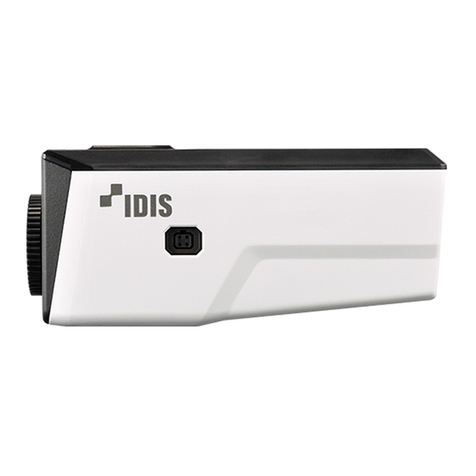
Idis
Idis DC-B6203XL User manual
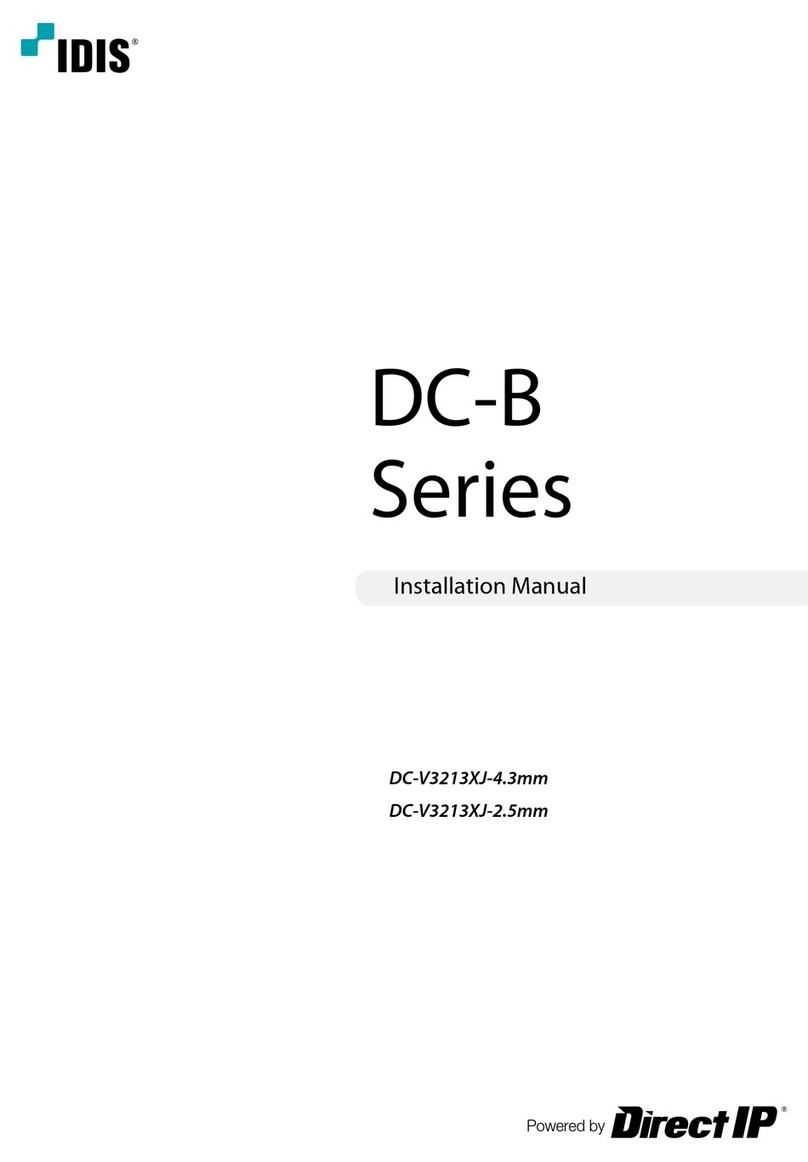
Idis
Idis DC-B Series User manual
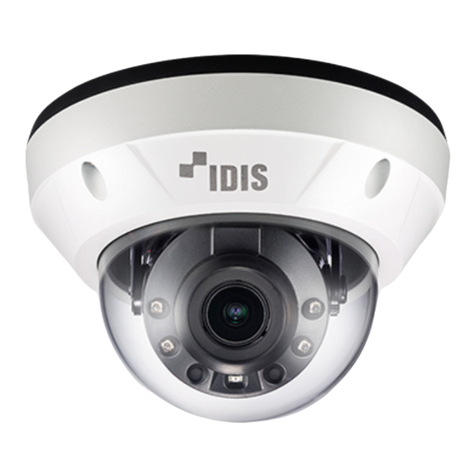
Idis
Idis TC-D5531RX User manual

Idis
Idis DC-B1803 User manual

Idis
Idis DC-B3303X User manual
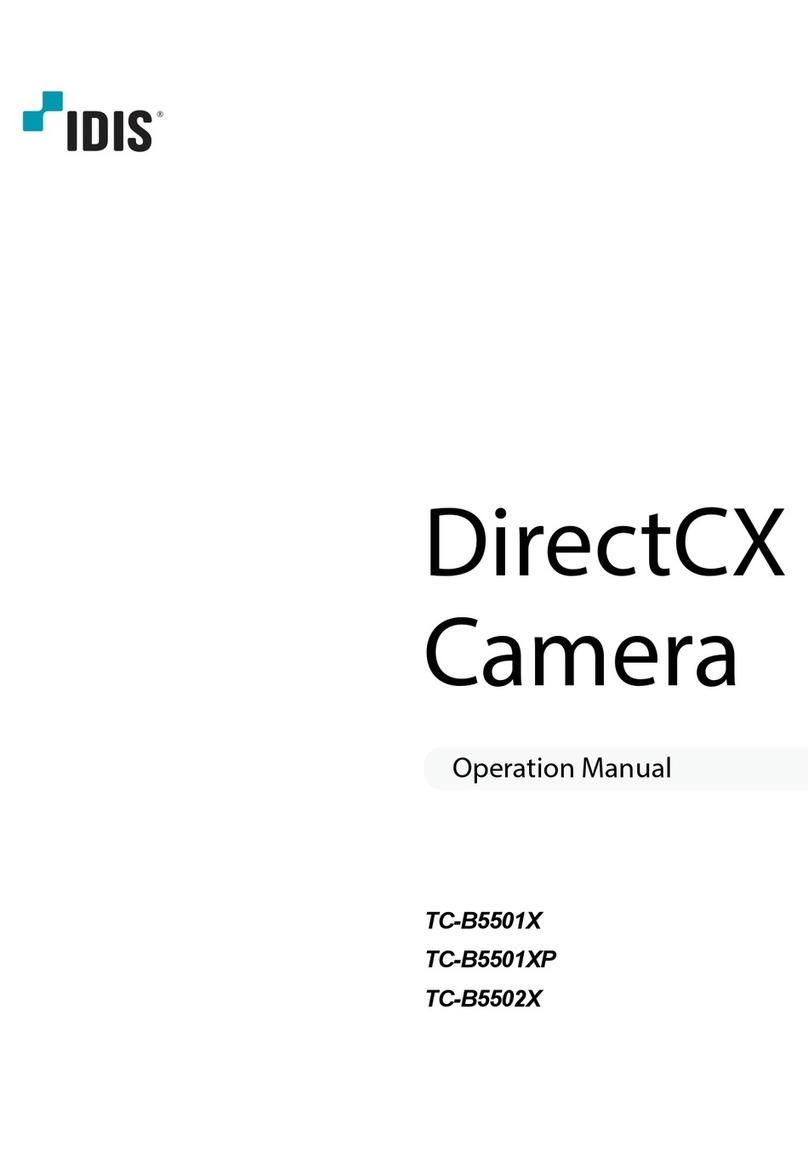
Idis
Idis DirectCX TC-B5502X User manual
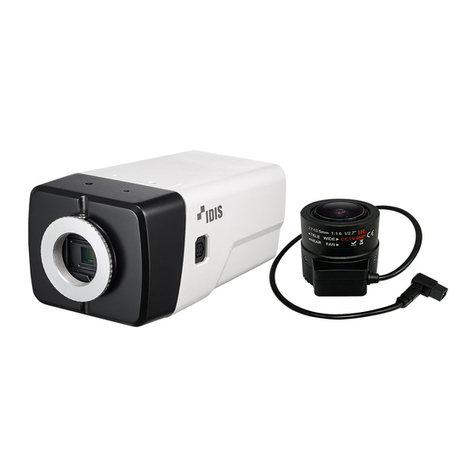
Idis
Idis DirectCX TC-B5501X User manual
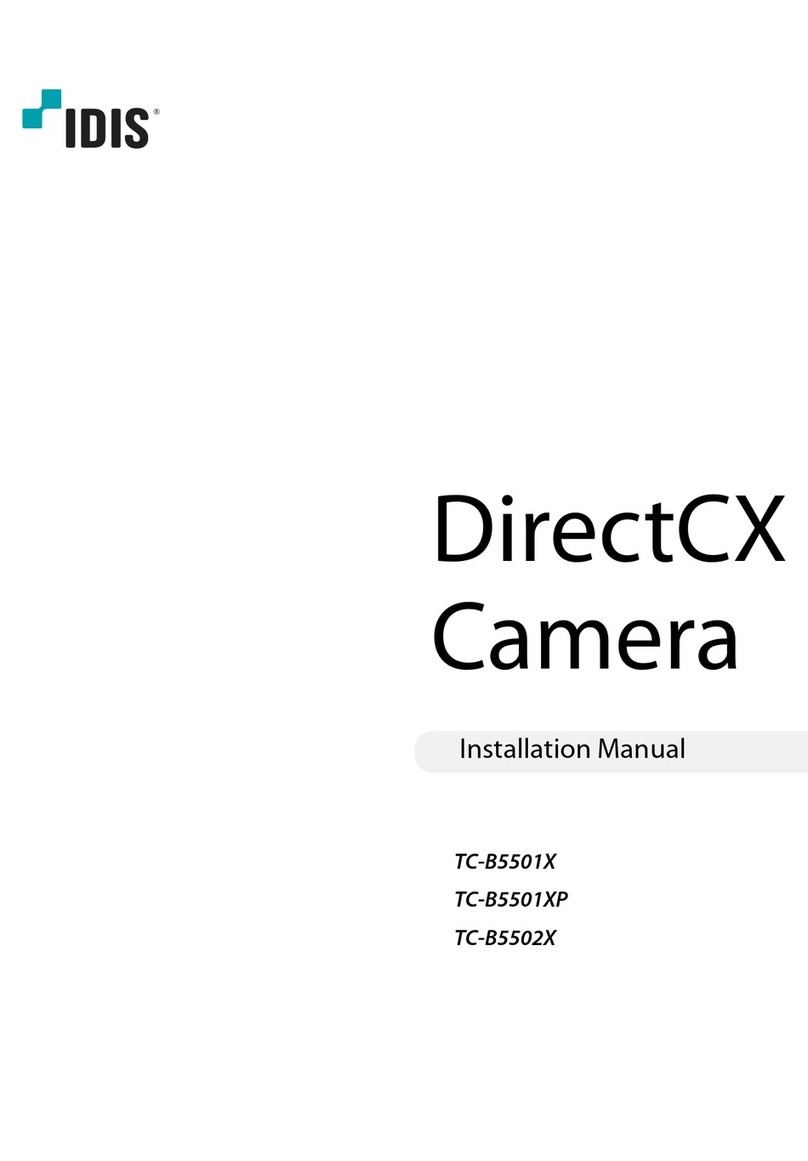
Idis
Idis DirectCX TC-B5501XP User manual
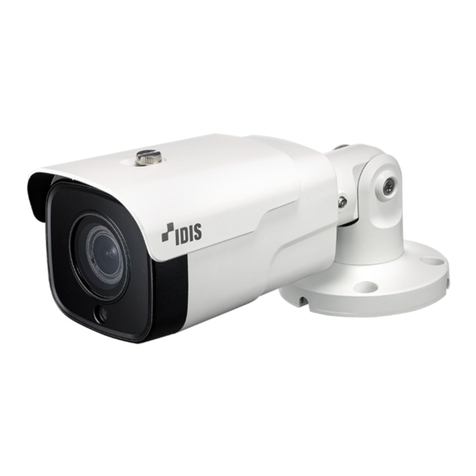
Idis
Idis DirectCX TC-T5531WRX User manual

Idis
Idis TC-D5531RX User manual


